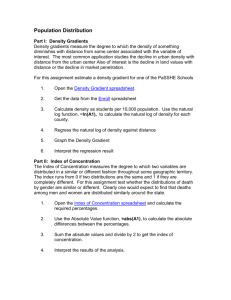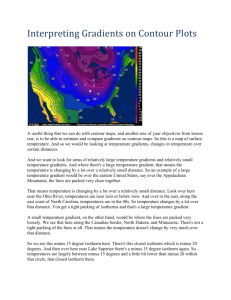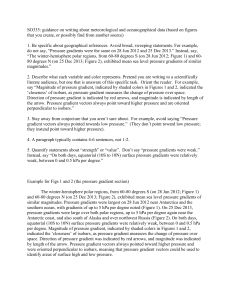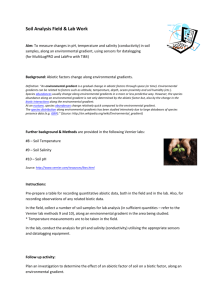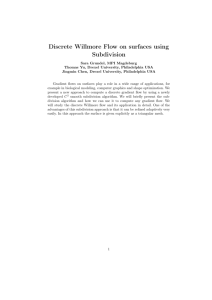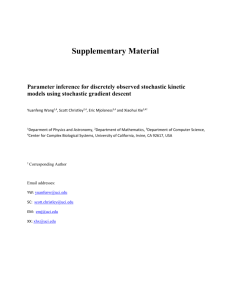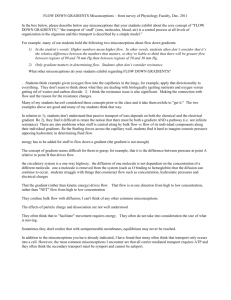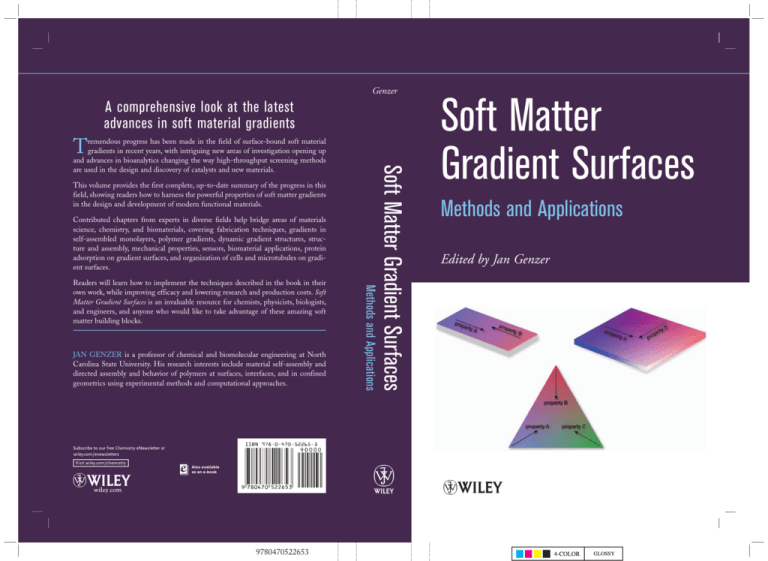
Genzer
A comprehensive look at the latest
advances in soft material gradients
T
This volume provides the first complete, up-to-date summary of the progress in this
field, showing readers how to harness the powerful properties of soft matter gradients
in the design and development of modern functional materials.
Contributed chapters from experts in diverse fields help bridge areas of materials
science, chemistry, and biomaterials, covering fabrication techniques, gradients in
self-assembled monolayers, polymer gradients, dynamic gradient structures, structure and assembly, mechanical properties, sensors, biomaterial applications, protein
adsorption on gradient surfaces, and organization of cells and microtubules on gradient surfaces.
Jan GENZER is a professor of chemical and biomolecular engineering at North
Carolina State University. His research interests include material self-assembly and
directed assembly and behavior of polymers at surfaces, interfaces, and in confined
geometrics using experimental methods and computational approaches.
9780470522653
Methods and Applications
Readers will learn how to implement the techniques described in the book in their
own work, while improving efficacy and lowering research and production costs. Soft
Matter Gradient Surfaces is an invaluable resource for chemists, physicists, biologists,
and engineers, and anyone who would like to take advantage of these amazing soft
matter building blocks.
Soft Matter Gradient Surfaces
remendous progress has been made in the field of surface-bound soft material
gradients in recent years, with intriguing new areas of investigation opening up
and advances in bioanalytics changing the way high-throughput screening methods
are used in the design and discovery of catalysts and new materials.
Soft Matter
Gradient Surfaces
Methods and Applications
Edited by Jan Genzer
SOFT MATTER
GRADIENT SURFACES
Methods and Applications
Edited by
JAN GENZER
Department of Chemical and Biomolecular Engineering
North Carolina State University
A JOHN WILEY & SONS, INC., PUBLICATION
Copyright © 2012 John Wiley & Sons, Inc. All rights reserved.
Published by John Wiley & Sons, Inc., Hoboken, New Jersey.
Published simultaneously in Canada.
No part of this publication may be reproduced, stored in a retrieval system, or transmitted in any
form or by any means, electronic, mechanical, photocopying, recording, scanning, or otherwise,
except as permitted under Section 107 or 108 of the 1976 United States Copyright Act, without
either the prior written permission of the Publisher, or authorization through payment of the
appropriate per-copy fee to the Copyright Clearance Center, Inc., 222 Rosewood Drive, Danvers,
MA 01923, (978) 750-8400, fax (978) 750-4470, or on the web at www.copyright.com. Requests
to the Publisher for permission should be addressed to the Permissions Department, John Wiley &
Sons, Inc., 111 River Street, Hoboken, NJ 07030, (201) 748-6011, fax (201) 748-6008, or online at
http://www.wiley.com/go/permission.
Limit of Liability/Disclaimer of Warranty: While the publisher and author have used their best
efforts in preparing this book, they make no representations or warranties with respect to the
accuracy or completeness of the contents of this book and specifically disclaim any implied
warranties of merchantability or fitness for a particular purpose. No warranty may be created or
extended by sales representatives or written sales materials. The advice and strategies contained
herein may not be suitable for your situation. You should consult with a professional where
appropriate. Neither the publisher nor author shall be liable for any loss of profit or any other
commercial damages, including but not limited to special, incidental, consequential, or other
damages.
For general information on our other products and services or for technical support, please contact
our Customer Care Department within the United States at (800) 762-2974, outside the United
States at (317) 572-3993 or fax (317) 572-4002.
Wiley also publishes its books in a variety of electronic formats. Some content that appears in print
may not be available in electronic formats. For more information about Wiley products, visit our
web site at www.wiley.com.
Library of Congress Cataloging-in-Publication Data:
Soft matter gradient surfaces : methods & applications / edited by Jan Genzer.
p. cm.
Includes bibliographical references and index.
ISBN 978-0-470-52265-3 (hardback)
1. Functionally gradient materials. 2. Surfaces (Technology) I. Genzer, Jan.
TA418.9.F85S64 2012
620.1 18–dc23
2011041447
Printed in the United States of America
10 9 8 7 6 5 4 3 2 1
CONTENTS
Contributors
vii
Preface
xi
1
Gradient Libraries: Harnessing a Ubiquitous Phenomenon
to Accelerate Experimentation
1
Michael J. Fasolka
2
Classification of Key Attributes of Soft Material Gradients
19
Jan Genzer and Rajendra R. Bhat
3
Discovery and Optimization of Sensing Materials Using
Discrete and Gradient Arrays
47
Radislav A. Potyrailo
4
Colliding Self-Assembly Waves in Organosilane Monolayers
93
Kirill Efimenko, Ali E. Özçam, Jan Genzer, Daniel A. Fischer,
Fredrick R. Phelan, and Jack F. Douglas
5
Orientational Anchoring of Liquid Crystals on Surfaces
Presenting Continuous Gradients in Composition
109
Jugal K. Gupta, Kirill Efimenko, Daniel A. Fischer, Jan Genzer,
and Nicholas L. Abbott
v
vi
6
CONTENTS
Continuous Infusion Microchannel Approach to Generate
Composition Gradients from Viscous Polymer Solutions
129
Pratyay Basak, Pedro Zapata, Keith Reed, Ismael Gomez,
and J. Carson Meredith
7
Gradient Assembly of Complex Surfaces for Sensing,
Fabrication, and High Throughput Analysis
145
Andrew C. Hillier
8
Making Gradient Patterns by Electron-Beam Chemical
Lithography with Monomolecular Resists
199
Nirmalya Ballav, Andreas Terfort, and Michael Zharnikov
9
Electrochemical Mapping for Polymer Chemical
and Physical Gradients
229
Roger H. Terrill, Xuejun Wang, and Paul W. Bohn
10 Directed Assembly of Block Copolymer Films: Effects
of Rough Substrates and Thermal Fields
257
Manish M. Kulkarni, Alamgir Karim, and Kevin G. Yager
11 Hydrogel Gradients by Self-Initiated Photografting
and Photopolymerization: Preparation, Characterization,
and Protein Interactions
279
Tobias Ekblad, Andréas Larsson, and Bo Liedberg
12 Polymer Gradients: Responsive Grafted Layers
303
Igor Luzinov and Sergiy Minko
13 Bioactive Self-Assembled Monolayer Gradients
329
Nicole M. Moore and Matthew L. Becker
14 Morphology Gradients on Different Size Scales and Their
Application in Biological Studies
365
Christian Zink and Nicholas D. Spencer
15 Molecularly Defined Peptide Spacing Gradients for Cell
Guidance
383
Vera C. Hirschfeld-Warneken and Joachim P. Spatz
16 Motion of Drops on Gradient Surfaces
407
R. Shankar Subramanian
Index
431
CONTRIBUTORS
Nicholas L. Abbott, Department of Chemical and Biological Engineering,
University of Wisconsin–Madison, Madison, Wisconsin, USA
Nirmalya Ballav, Angewandte Physikalische Chemie, Universität Heidelberg,
Heidelberg, Germany; Department of Chemistry, Indian Institute of Science
Education and Research, Pune, India
Pratyay Basak, School of Chemical and Biomolecular Engineering, Georgia
Institute of Technology, Atlanta, Georgia, USA; Lawrence Berkeley National
Laboratory, California, USA
Matthew L. Becker, Department of Polymer Science, University of Akron,
Akron, Ohio, USA
Rajendra R. Bhat, Department of Chemical and Biomolecular Engineering,
North Carolina State University, Raleigh, North Carolina, USA; Becton
Dickinson (BD) Technologies, Durham, North Carolina, USA
Paul W. Bohn, Department of Chemical and Biomolecular Engineering and
Department of Chemistry and Biochemistry, University of Notre Dame, Notre
Dame, Indiana, USA
Jack F. Douglas, Polymers Division, National Institute of Standards and Technology, Gaithersburg, Maryland, USA
Kirill Efimenko, Department of Chemical and Biomolecular Engineering, North
Carolina State University, Raleigh, North Carolina, USA
vii
viii
CONTRIBUTORS
Tobias Ekblad, Division of Molecular Physics, Department of Physics,
Chemistry and Biology, Linköping University, Linköping, Sweden
Michael J. Fasolka, Material Measurement Laboratory, National Institute of
Standards and Technology, Gaithersburg, Maryland, USA
Daniel A. Fischer, Ceramics Division, National Institute of Standards and Technology, Gaithersburg, Maryland, USA
Jan Genzer, Department of Chemical and Biomolecular Engineering, North
Carolina State University, Raleigh, North Carolina, USA
Ismael Gomez, School of Chemical and Biomolecular Engineering, Georgia
Institute of Technology, Atlanta, Georgia, USA
Jugal K. Gupta, Department of Chemical and Biological Engineering, University
of Wisconsin–Madison, Madison, Wisconsin, USA
Andrew C. Hillier, Department of Chemical and Biological Engineering, Iowa
State University, Ames, Iowa, USA
Vera C. Hirschfeld-Warneken, Biophysical Department, Institute of Physical
Chemistry, University of Heidelberg, Heidelberg, Germany; Department of
New Materials and Biosystems, Max Planck Institute for Intelligent Systems
(formerly Metals Research), Stuttgart, Germany
Alamgir Karim, Department of Polymer Engineering, University of Akron,
Akron, Ohio, USA
Manish M. Kulkarni, Department of Polymer Engineering, University of Akron,
Akron, Ohio, USA
Andréas Larsson, Division of Molecular Physics, Department of Physics,
Chemistry and Biology, Linköping University, Linköping, Sweden
Bo Liedberg, Division of Molecular Physics, Department of Physics, Chemistry
and Biology, Linköping University, Linköping, Sweden
Igor Luzinov, School of Materials Science and Engineering, Clemson University,
Clemson, South Carolina, USA
J. Carson Meredith, School of Chemical and Biomolecular Engineering, Georgia
Institute of Technology, Atlanta, Georgia, USA
Sergiy Minko, Department of Chemistry and Biomolecular Science, Clarkson
University, Potsdam, New York, USA
Nicole M. Moore, Polymers Division, National Institute of Standards and Technology, Gaithersburg, Maryland, USA
Ali E. Özçam, Department of Chemical and Biomolecular Engineering, North
Carolina State University, Raleigh, North Carolina, USA
CONTRIBUTORS
ix
Fredrick R. Phelan, Polymers Division, National Institute of Standards and
Technology, Gaithersburg, Maryland, USA
Radislav A. Potyrailo, Chemistry Technologies and Material Characterization,
General Electric Global Research, Niskayuna, New York, USA
Keith Reed, School of Chemical and Biomolecular Engineering, Georgia Institute
of Technology, Atlanta, Georgia, USA
Joachim P. Spatz, Biophysical Department, Institute of Physical Chemistry,
University of Heidelberg, Heidelberg, Germany; Department of New Materials
and Biosystems, Max Planck Institute for Metals Research, Stuttgart, Germany
Nicholas D. Spencer, Laboratory for Surface Science and Technology, Department of Materials, ETH Zurich, Zurich, Switzerland
R. Shankar Subramanian, Department of Chemical and Biomolecular Engineering and Center for Advanced Materials Processing, Clarkson University,
Potsdam, New York, USA
Andreas Terfort, Institut für Anorganische und Analytische Chemie, GoetheUniversität Frankfurt, Frankfurt, Germany
Roger H. Terrill, Department of Chemistry, San Jose State University, San Jose,
California, USA
Xuejun Wang, Nalco Company, Naperville, Illinois, USA
Kevin G. Yager, Center for Functional Nanomaterials, Brookhaven National
Laboratory, Upton, New York, USA
Pedro Zapata, School of Chemical and Biomolecular Engineering, Georgia
Institute of Technology, Atlanta, Georgia, USA; Intel Corporation, Hillsboro,
Oregon, USA
Michael Zharnikov, Angewandte Physikalische Chemie, Universität Heidelberg,
Heidelberg, Germany
Christian Zink, Laboratory for Surface Science and Technology, Department of
Materials, ETH Zurich, Zurich, Switzerland
PREFACE
Although it was first introduced by the French physicist Madeleine Veyssié around
1970, the term soft matter caught true attention only after Pierre-Gilles de Gennes
used it in his Nobel speech in 1991. Soft matter represents a very rapidly developing subset of structures generally called condensed matter. It encompasses
both naturally occurring structures (i.e., biomolecules) and synthetic substances
(i.e., liquids, liquid crystals, colloids, membranes, gels, foams, and many subsets thereof). These structures range in size from a single chemical repeat unit
to molecular clusters to large macromolecules made up of thousands of repeat
units. One feature that distinguishes soft materials from hard condensed matter
is that the former can be deformed readily by applying some external force (i.e.,
mechanical, electrical, or magnetic). Governed by short and long range interactions, the individual soft matter building blocks can organize into well-ordered
structures, spanning nanoscopic (molecular) to mesoscopic (cluster-like) length
scales. Although in most instances, the organization takes place spontaneously via
self-assembly driven primarily by van der Waals interactions, additional fine tuning can be achieved by applying an external field or by forcing the self-assembly
to take place in the confined spaces of various geometries. Nowadays, the field
of soft materials represents an exciting meeting arena for chemists, physicists,
biologists, and engineers who design, build, and probe the characteristics of both
the individual blocks and larger assemblies made up of those blocks.
Self-assembly of soft materials at or near interfaces or surfaces offers additional benefits in that (i) it provides control over system dynamics, that is, depending on the system setup, the building blocks can be either completely mobile
or immobilized temporarily or permanently; (ii) novel self-assembly motifs can
be generated that are not necessarily obtainable in bulk; and (iii) the spatial
xi
xii
PREFACE
distribution of the assembly patterns can be adjusted by depositing the individual
building blocks onto substrates of various geometries and chemistries. The characteristics of the discrete building blocks as well as their spatial arrangement,
in turn, endow such structures with unprecedented properties and functionalities.
Numerous publications have reported on the interfacial assembly of soft materials and the advantages they provide in controlling functionality of surfaces,
and studying important physico-chemical phenomena by means of sophisticated
analytical methods and tools.
Initial research effort was focused on the organization of “soft” materials
on chemically homogeneous interfaces. However, recent advances in methods
of fabricating chemically structured interfaces enabled control over the spatial
arrangement of soft materials. A variety of lithographic and other assembling
methods have been developed that decorate substrates with soft materials exhibiting well-defined shapes, sizes, and dimensionalities. The robustness, simplicity,
and versatility of such assembling technologies made these tools popular among
scientists and engineers. Yet, these methods are inherently limited in their ability
to readily fabricate substrates whose physico-chemical character changes gradually as a function of position and/or evolves in time (though some notable
exceptions exist). A question immediately arises as to whether the means of
generating substrates displaying spatio-temporal change of at least one physicochemical characteristic, that is, chemical composition, charge, molecular mobility,
or modulus, are really needed. It is the hope of the authors of this collection to
convince the reader that soft matter gradients, which show such gradual change
in properties, represent unique structures that can play a pivotal role in the development of modern functional materials.
Over the past half century, material gradients, both continuous and discrete,
have enabled fast screening of physico-chemical phenomena in a systematic
manner. These structures have facilitated major breakthroughs in combinatorial
chemistry and materials science, especially in the design and discovery of catalysts and drugs, thereby bringing about rapid technological developments with
improved efficiency and lower research and production costs. While the application of gradients in combinatorial screening represents perhaps the most prevalent
utilization of gradient surfaces, it is not the only one. For example, techniques of
fabrication of gradient assemblies have often been used as facile means of monitoring a given physico-chemico–biological process by “recording” it gradually
and systematically on the substrate. Gradient patterns on surfaces can also be utilized as surface-bound “directional engines” capable of acting as molecular and
macromolecular motors for moving objects whose dimensions are comparable
with the spatial extent of the gradient. This, coupled with the ability to change
the physico-chemical character of the substrate in real time using techniques and
processes discussed later in this book, may offer unique new opportunities for
controlling the motion of liquids and/or certain biological species such as living cells. Finally, gradient structures have also inspired the development of new
analytical approaches and measurement tools.
PREFACE
xiii
While the progress in generating and utilizing soft material gradient surfaces has been summarized in several review articles written during the past
two decades, to the best of our knowledge, no dedicated monograph has been
published that provides an overview of the field and summarizes the rapid development witnessed by this field over the past few years. With this volume, we
intend to close this gap and provide an up-to-date collection of topics pertaining to the latest developments in the field of soft material gradient research.
Combinatorial/high throughput methods utilizing “hard materials” have not been
covered because these have been the subject of other monographs.
I would like to extend my most profound thanks to all the authors who contributed to this book. It has been an exciting opportunity to work with all of
you in putting this book together. I hope that the readers will find the contributions included in this book informative and stimulating. Perhaps, reviewing the
contributions in this book will bring about new ideas of how to implement the
advances made in the fabrication of soft matter gradients in your own research.
Jan Genzer
Raleigh, North Carolina
October 2011

